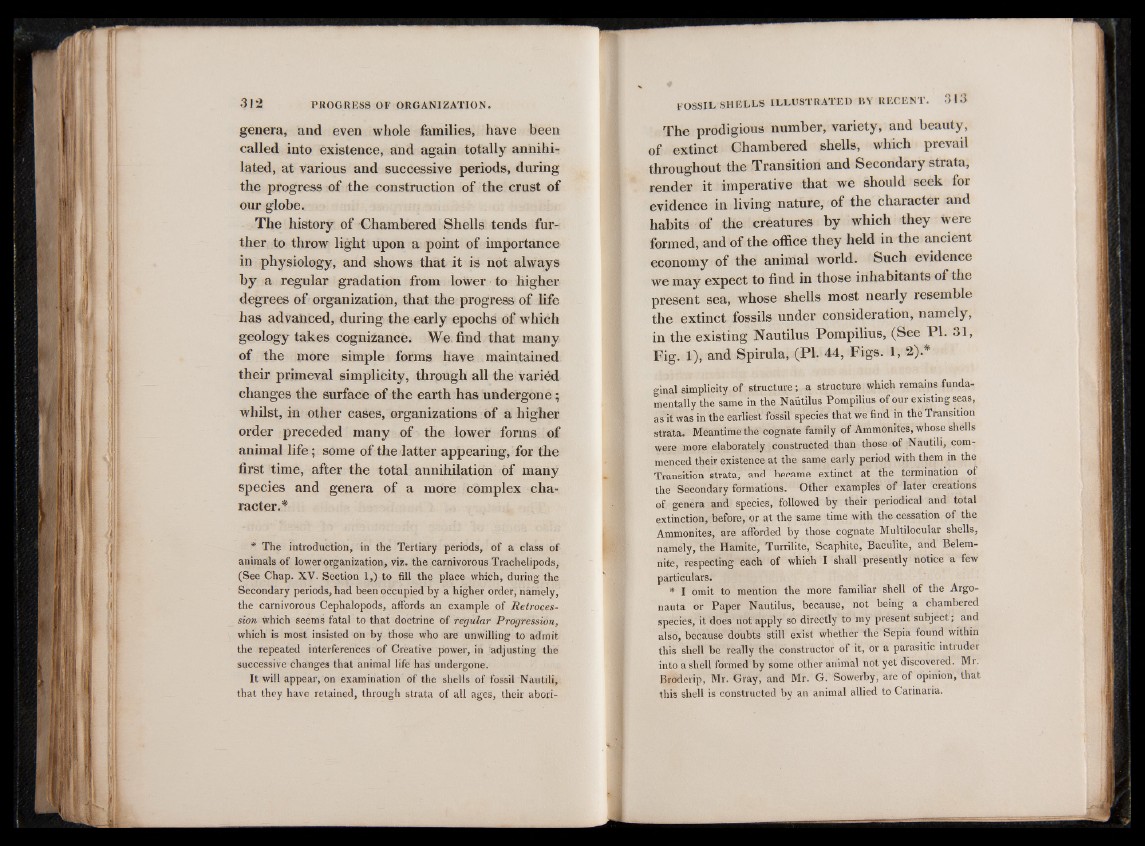
genera, and even whole families, have been
called into existence, and again totally annihilated,
at various and successive periods, during
the progress of the construction of the crust of
our globe.
The history of Chambered Shells tends further
to throw light upon a point of importance
in physiology, and shows that it is not always
by a regular gradation from lower to higher
degrees of organization, that the progress of life
has advanced, during the early epochs of which
geology takes cognizance. We find that many
of the more simple forms have maintained
their primeval simplicity, through all the varied
changes the surface of the earth has undergone;
whilst, in other cases, organizations of a higher
order preceded many of the lower forms of
animal life; some of the latter appearing, for the
first time, after the total annihilation of many
species and genera of a more complex character.*
* The introduction, in the Tertiary periods, of a class of
animals of lower organization, viz. the carnivorous Trachelipods,
(See Chap. XV. Section 1,) to fill the place which, during the
Secondary periods, had been occupied by a higher order, namely,
the carnivorous Cephalopods, affords an example of Retrocession
which seems fatal to that doctrine of regular Progression,
which is most insisted on by those who are unwilling to admit
the repeated interferences of Creative power, in adjusting the
successive changes that animal life has undergone.
It will appear, on examination of the shells of fossil Nautili,
that they have retained, through strata of all ages, their abori-
The prodigious number, variety, and beauty,
of extinct Chambered shells, which prevail
throughout the Transition and Secondary strata,
render it imperative that we should seek for
evidence in living nature, of the character and
habits of the creatures by which they were
formed, and of the office they held in the ancient
economy of the animal world. Such evidence
we may expect to find in those inhabitants of the
present sea, whose shells most nearly resemble
the extinct fossils under consideration, namely,
in the existing Nautilus Pompilius, (See PI. 31,
Fig. 1), and Spirula, (PI. 44, Figs. 1, 2).*
ginal simplicity of structure; a structure which remains fundamentally
the same in the Nautilus Pompilius of our existing seas,
as it was in the earliest fossil species that we find in the Transition
strata. Meantime the cognate family of Ammonites, whose shells
were more elaborately constructed than those of Nautili, commenced
their existence at the same early period with them in the
Transition strata, and became extinct at the termination of
the Secondary formations. Other examples o f later creations
of genera and species, followed by their periodical and total
extinction, before, or at the same time with the cessation of the
Ammonites, are afforded by those cognate Multilocular shells,
namely, the Hamite, Turrilite, Scaphite, Baculite, and Belem-
nite, respecting each of which I shall presently notice a few
particulars.
* I omit to mention the more familiar shell of the Argo-
nauta or Paper Nautilus, because, not being a chambered
species, it does not apply so directly to my present subject; and
also, because doubts still exist whether the Sepia found within
this shell be really the constructor of it, or a parasitic intruder
into a shell formed by some other animal not yet discovered. Mr.
Broderip, Mr. Gray, and Mr. G. Sowerby, are of opinion, that
this shell is constructed by an animal allied to Carinaria.